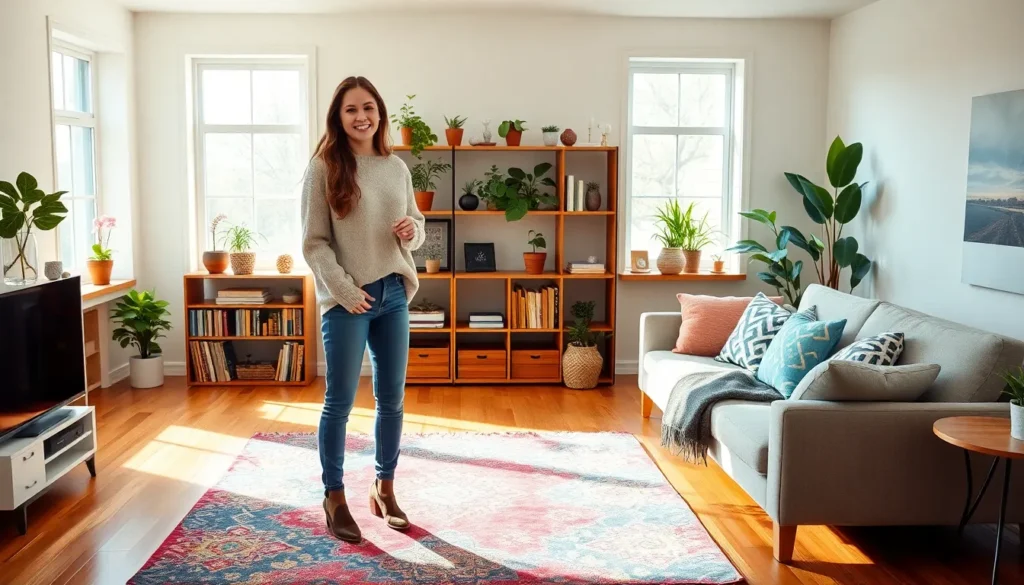Table of Contents
ToggleStepping into a new house feels like unwrapping a gift, but that excitement can quickly turn into a decorating dilemma. How do you turn those blank walls and empty rooms into a cozy haven that reflects your personality? Fear not, because decorating doesn’t have to be a chore—it can be a delightful adventure filled with creativity and a sprinkle of humor.
Imagine transforming your living space into a masterpiece that not only impresses guests but also makes you feel like royalty in your own castle. With a few clever tips and tricks, you can navigate the world of color palettes, furniture placement, and quirky decor without losing your sanity—or your sense of style. So grab your paintbrush and let’s dive into the whimsical world of home decorating, where every room tells a story and every choice sparks joy.
Understanding Your Style
Identifying a personal style is essential for creating a cohesive look in a new home. Individual preferences guide choices in colors, furniture, and decor.
Defining Your Aesthetic
Identifying your aesthetic involves exploring various styles, such as modern, rustic, or eclectic. Elements from each style help create a unique blend that reflects personality. Experiment with samples of fabrics and paints to visualize how they resonate in your space. Keep in mind that gathering inspiration from magazines or social media platforms aids in clarifying preferences. Viewing other homes can also spark creativity, leading to a more defined personal style.
Researching Trends
Staying informed about decor trends enhances the decorating process. Various resources, such as design blogs and home improvement shows, offer fresh ideas. Following popular designers on social media provides real-time inspiration and showcases current trends. Attending local home shows or visiting showrooms introduces innovative concepts and materials. Recognizing market shifts allows for thoughtful adaptations in style, ensuring it remains contemporary while still feeling personal.
Planning Your Space

Planning the space enhances the decorating experience. It involves thoughtful consideration of layout and budget.
Creating a Layout
Designing a layout provides the foundation for any decorating project. Start by measuring the rooms to understand dimensions. Next, consider the flow of movement, placing furniture where it supports easy navigation. Filling the space with functional pieces ensures every item serves a purpose. Furthermore, sketching a floor plan can visualize arrangements and avoid overcrowding. Different zones can be established for various activities, such as lounging or dining. Embracing both aesthetics and practicality leads to a balanced environment.
Setting a Budget
Establishing a budget serves as a crucial step in the decorating process. Begin by calculating overall costs, including furniture, decor, and materials. Listing priorities helps allocate funds appropriately. Allowing a margin for unexpected expenses ensures flexibility. Researching prices online and in-store can uncover deals and sales. Exploring second-hand options often results in unique finds. Balancing quality and cost avoids overspending while achieving desired results.
Choosing Color Schemes
Choosing a color scheme sets the tone for a new house. It influences mood and showcases personality through vibrant palettes and subtle neutrals.
Selecting Paint Colors
Selecting paint colors acts as a foundation for each room. Neutrals provide a versatile backdrop, allowing for easier furniture integration. Warm tones evoke warmth, while cool hues encourage calmness. Testing samples on walls helps in visualizing the final effect under different lighting. Consider rooms’ purposes; a bright color may energize a home office, while soothing tones work well in bedrooms. Additionally, balance is essential; coordinating shades throughout the space enhances visual harmony.
Incorporating Accents
Incorporating accents adds depth and character to the overall decor. Accent walls create focal points that attract attention. Bold choices like deep blue or vibrant red accentuate specific areas. Decorative items such as cushions, rugs, and curtains serve as complementary elements that tie the theme together. Integrating metallics can elevate a space, offering a sophisticated touch. A mix of textures through furniture and decor enriches the aesthetic, creating visual interest. Always reflect personal style in these choices to maintain a cohesive atmosphere throughout the home.
Furniture Selection
Furniture selection plays a crucial role in defining the character of a new home. Choosing the right pieces complements personal style while ensuring functionality.
Choosing the Right Pieces
Identifying essential furniture pieces involves assessing needs, functionality, and space. Sofas should provide comfort and align with the home’s aesthetic. Dining tables must accommodate gatherings while being proportionate to the room. Beds play a vital role in bedroom design, combining comfort and style. When selecting furniture, prioritize quality materials for longevity and visual appeal. Mixing materials, like wood and metal, can add interest to spaces. Consider color schemes that resonate with personal style, ensuring cohesion throughout the home.
Arranging for Comfort
Arranging furniture thoughtfully enhances comfort and usability. Establishing a focal point, such as a fireplace or artwork, directs layout choices. Sofas should be placed to promote conversation, allowing for easy interaction. Creating pathways for movement is essential, ensuring a natural flow in high-traffic areas. Placing rugs under seating areas visually connects pieces and adds warmth. For zones designated for specific activities, furniture should serve dual purposes when possible. Accessorizing with cushions and throws not only improves comfort but also reinforces style.
Accessories and Finishing Touches
Decorating a new home involves thoughtful accessories and finishing touches that bring personality into the space. These elements enhance warmth and create a lived-in atmosphere.
Adding Personal Elements
Incorporating personal items fosters connection and uniqueness in any space. Family photos displayed in stylish frames tell stories that resonate. Artwork from local artists captures the essence of the community, making visitors feel welcome. Heirlooms also provide a sense of history, grounding the home in sentiment. By selecting decor that reflects individual experiences, the overall design emerges as a cohesive narrative. Small trinkets and souvenirs serve as conversation starters, inviting guests into shared memories.
Layering Textures
Layering textures creates depth and visual interest in decorative arrangements. Soft blankets draped over furniture provide both comfort and style. Different fabric choices, like silk cushions paired with knitted throws, enhance tactile appeal. Natural materials, such as wood or stone, add organic warmth to the environment. Mixing patterns, like stripes with florals, introduces a playful aspect. Plants not only bring life to surfaces, but they also contribute varying textures that enhance overall design. Diverse textures elevate the space from ordinary to extraordinary, inviting exploration and engagement.
Decorating a new house is an exciting journey that allows for personal expression and creativity. By embracing the process and understanding individual style, anyone can transform their space into a reflection of their personality.
Thoughtful planning and furniture selection play vital roles in creating a functional and inviting environment. Adding unique accessories and personal touches further enhances the warmth and character of the home.
Ultimately, the goal is to cultivate a space that feels comfortable and welcoming. With a little patience and creativity, turning a house into a cherished home becomes an enjoyable adventure.





